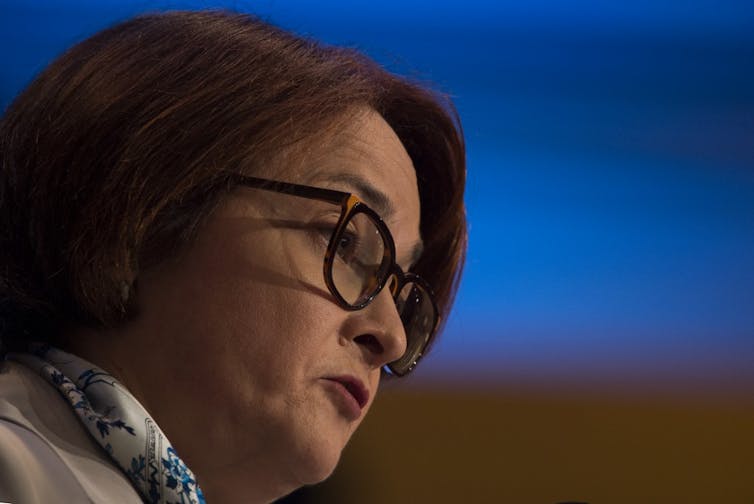
Seven weeks into the war, how is the Russian economy faring? The short answer is: well below expectations and the worse is yet to come.
Before the war, the Russian economy was stagnating but allegedly safe from macroeconomic crises. To use an image commonly employed by economists: it was stuck in a bog and therefore unlikely to fall off a cliff.
On the one hand, since 2013 Russia’s GDP has grown on average around 1% per year. Corruption, a burdensome state, politically captive businessmen and isolation from the global economy have all added up to undermine the country’s potential growth. On the other hand, a low sovereign debt, substantial sovereign wealth fund as well as large foreign exchange reserves assured the country’s macroeconomic stability. Conservative fiscal rule and modern inflation-targeting monetary policies also contributed to steady modest growth.
So, in the run-up to the war, economists would customarily describe Russian macroeconomics as a sanction-proof, “fortress Russia”. The country’s economic policymakers thought the worst damage the West could inflict would be to disconnect the Russian financial system from the global interbank payment system SWIFT. After the United States threatened to cut Russia off from SWIFT in 2014, the country started to develop a domestic alternative, SPFS (System for Transferring Financial Messages). While imperfect and limited to Russia, it has been functional since 2017.
The West takes aim at Fortress Russia
Once the war started, however, the West responded with much stronger sanctions. The main tower of “fortress Russia” was reduced to rubble. Sanctions also targeted the Russian Central Bank, freezing foreign currency reserves that included the sovereign wealth fund.
The ensuing financial panic prompted the Central Bank to enforce capital controls, hike its key interest rate from 9.5% to 20% and close financial markets for several weeks. The government also instructed major fossil fuel exporters to repatriate 80% of their export revenues as rubles. Despite this, inflation soared to 2% per week in the first three weeks of the war and then 1% per week thereafter (1% per week is equivalent to 68% annually).
Export controls and a boycott by Western firms of the Russian market have further severed Russia from the global economy. The US and Canada have banned the purchase of Russian oil, and many European companies have followed their lead out of their own accord. More importantly, the United States and Europe have prohibited exporting advanced technology to Russia, with the private sector also joining the embargo. Companies ranging from Ikea and McDonald’s to Airbus and Boeing have suspended operations in the country.
It turns out that most Russian industry critically relies on Western technology and inputs. For example, the Russian car sector has ground to a halt – as it suddenly discovered its extreme dependency on imported components. Car sales in March 2022 were three times lower than in March 2021. This is especially striking as during periods of high inflation, households tend to try to buy durable goods.

Gathering clouds
This is why it is not surprising that the 2022 GDP forecasts were immediately downgraded. Before the war, Russian GDP was supposed to grow in 2022 by 3% as it recovered from the pandemic-induced recession. Today, the Central Bank’s forecast is an 8% decline. The European Bank for Reconstruction and Development expects a 10% decline. The Washington-based Institute for International Finance projects a 15% drop. A 10% decline (and this forecast is supported by many investment banks) would make it Russia’s worst recession since the early 1990s.
However, the worst is yet to come. Even though the Russian economy could possibly adjust to a new equilibrium in a year or two, it will fail to recover any time soon to pre-war levels; Russia will continue falling behind developed economies. First, sanctions will keep it isolated from the global capital market and from advanced technology. Second, it has shifted to a highly repressive regime that will destroy opportunities for domestic entrepreneurs. Third, in the first few weeks of the war it had already lost hundreds of thousands of skilled workers, who understood that staying in Russia is neither safe nor conducive to their careers. These are educated professionals, IT specialists, researchers, engineers, and doctors. Russia’s loss of their best human capital will continue further, undermining its growth prospects.
Finally, it is likely that the West will impose additional sanctions. As evidence of alleged Russian war crimes continues to mount, there is growing pressure on European politicians to target the backbone of Russia’s economy – hydrocarbons. In recent years, oil and gas alone accounted for 35-40% of the federal budget revenue and made up 60% of Russian exports. The European Parliament has already passed a resolution demanding an embargo on Russian imports of fossil fuels. And the EU’s top diplomat Josep Borrell said, “sooner or later – I hope sooner – it will happen”. When the European oil and gas embargo is introduced, Russia will face major fiscal challenges – which will further reduce its growth potential. Also, as Europe joins the US and Canada, the united West will mount pressure on China – thus eliminating Russia’s hopes that China’s money and technology can replace those of the West.
Even as the Central Bank’s capital and currency controls are helping to shore up the ruble and eventually slow down inflation, the fundamental factors above will definitely make Russia’s recovery to pre-war levels unlikely – not to begin to mention catching up with its neighbours.
How soon this economic shock will result in political change is anybody’s guess. But eventually, Mr. Putin will run out of resources to pay his soldiers, propagandists, mercenaries, and policemen to keep the increasingly unhappy Russians in check.
Sergei Guriev does not work for, consult, own shares in or receive funding from any company or organization that would benefit from this article, and has disclosed no relevant affiliations beyond their academic appointment.
This article was originally published on The Conversation. Read the original article.







